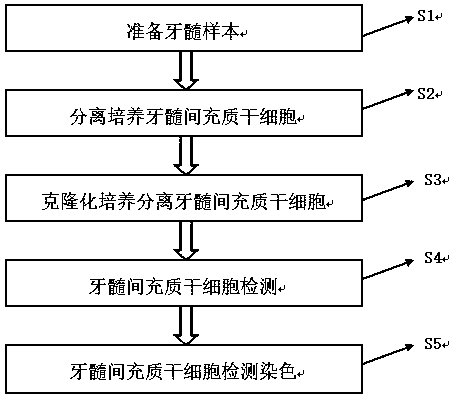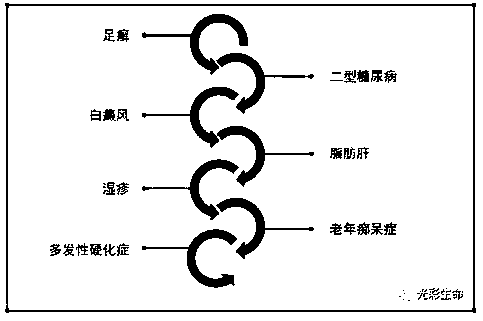Culture method of dental pulp mesenchymal stem cells
A technology of mesenchymal stem cells and culture methods, applied in cell dissociation methods, tissue culture, animal cells, etc., can solve the problems of slow growth and slow adhesion of dental pulp stem cells, so as to promote healing and regeneration, arrange tightly, and delay aging Effect
- Summary
- Abstract
- Description
- Claims
- Application Information
AI Technical Summary
Problems solved by technology
Method used
Image
Examples
Embodiment 1
[0040] Such as Figure 1~2 As shown, a method for culturing dental pulp mesenchymal stem cells of the present invention comprises the following steps:
[0041]S1. Prepare the pulp sample: soak the tooth sample in buffer solution or refrigerate the tooth sample for 40h-47h, split the crown, the depth of the crown split is 0.6mm-0.9mm, and use The depth of the splitting of the crown, under aseptic conditions, exposes the pulp tissue, after which the pulp is removed. In this specific example, the tooth sample is the impacted complete third molar of a healthy adult aged 19-29, and the tooth surface needs to be sterilized before soaking and refrigerated storage. In addition, the most successful sources of dental pulp stem cells are healthy deciduous teeth and wisdom teeth. All 20 deciduous teeth can be used to extract dental pulp stem cells, and every child in the tooth replacement period is worth saving; if adults wish to have their wisdom teeth extracted, dental pulp stem cells...
Embodiment 2
[0049] A method for culturing dental pulp mesenchymal stem cells of the present invention comprises the following steps:
[0050] S1. Prepare the pulp sample: soak the tooth sample in buffer solution or refrigerate the tooth sample for 40h-47h, split the crown, the depth of the crown split is 0.6mm-0.9mm, and use The depth of the splitting of the crown, under aseptic conditions, exposes the pulp tissue, after which the pulp is removed. In this specific example, the tooth sample is the impacted complete third molar of a healthy adult aged 19-29, and the tooth surface needs to be sterilized before soaking and refrigerated storage. In addition, the most successful sources of dental pulp stem cells are healthy deciduous teeth and wisdom teeth. All 20 deciduous teeth can be used to extract dental pulp stem cells, and every child in the tooth replacement period is worth saving; if adults wish to have their wisdom teeth extracted, dental pulp stem cells can also be stored. Due to t...
Embodiment 3
[0059] Another method for culturing dental pulp mesenchymal stem cells of the present invention comprises the following steps:
[0060] S1. Prepare the pulp sample: soak the tooth sample in buffer solution or store the tooth sample in cold storage. The storage time is 40h-47h. Split the crown. The depth of the crown split is 0.6mm-0.9mm, and use The depth of the splitting of the crown, under aseptic conditions, exposes the pulp tissue, after which the pulp is removed. In this specific example, the tooth sample is the impacted complete third molar of a healthy adult aged 19-29, and the tooth surface needs to be sterilized before soaking and refrigerated storage. In addition, the most successful sources of dental pulp stem cells are healthy deciduous teeth and wisdom teeth. All 20 deciduous teeth can be used to extract dental pulp stem cells, and every child in the tooth replacement period is worth saving; if adults have the willingness to extract wisdom teeth, dental pulp stem...
PUM
 Login to View More
Login to View More Abstract
Description
Claims
Application Information
 Login to View More
Login to View More - R&D
- Intellectual Property
- Life Sciences
- Materials
- Tech Scout
- Unparalleled Data Quality
- Higher Quality Content
- 60% Fewer Hallucinations
Browse by: Latest US Patents, China's latest patents, Technical Efficacy Thesaurus, Application Domain, Technology Topic, Popular Technical Reports.
© 2025 PatSnap. All rights reserved.Legal|Privacy policy|Modern Slavery Act Transparency Statement|Sitemap|About US| Contact US: help@patsnap.com


